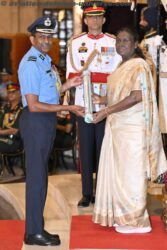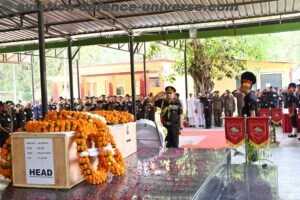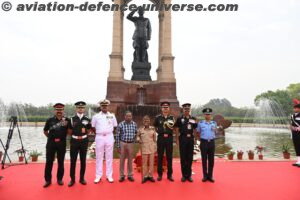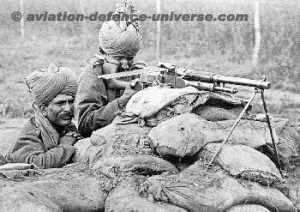
New Delhi. 11 November 2018. As the day dawns the nation is celebrating one of the greatest contribution India has made to world history – the Indian Army’s participation in the Great War or the World War I as we Indians know it.
The Indian Army during World War I contributed a large number of divisions and independent brigades to the European, Mediterranean and the Middle East theatres of war in World War I. Over one million Indian troops served overseas, of whom 62,000 died and another 67,000 were wounded. In total at least 74,187 Indian soldiers died during the war.
Field-Marshal Sir Claude Auchinleck, Commander-in-Chief of the Indian Army from 1942 asserted that the British “couldn’t have come through both wars [World War I and II] if they hadn’t had the Indian Army.
In World War I the Indian Army fought against the German Empire in German East Africa and on the Western Front. At the First Battle of Ypres, Khudadad Khan became the first Indian to be awarded a Victoria Cross. Indian divisions were also sent to Egypt, Gallipoli and nearly 700,000 served in Mesopotamia against the Ottoman Empire.While some divisions were sent overseas others had to remain in India guarding the North West Frontier and on internal security and training duties.
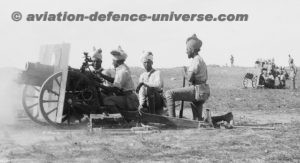
In 1914, the Indian Army was one of the two largest volunteer armies in the world with a total strength of 240,000 men while the British Army had a strength of 247,432 regular volunteers at the outbreak of the war. By November 1918, the Indian Army contained 548,311 men, being considered the Imperial Strategic Reserve. It was regularly called upon to deal with incursions and raids on the North West Frontier and to provide garrison forces for the British Empire in Egypt, Singapore and China.
This field force was divided into two armies: the Northern Army, which stretched from the North-West Frontier to Bengal with five divisions and three brigades under command, and the Southern Army which ranged from Baluchistan to southern India and it in turn had four divisions under command and two formations outside the subcontinent. The two armies contained 39 cavalry regiments, 138 infantry battalions (including 20 Gurkha), a joint cavalry-infantry unit, the Corps of Guides, three sapper regiments and 12 mountain artillery batteries.
The nine divisions formed by these reforms each consisted of one cavalry and three infantry brigades. The cavalry brigade had one British and two Indian regiments while the infantry brigades consisted of one British and three Indian battalions. Indian Army battalions were smaller than the British battalions, consisting of 30 officers and 723 other ranks as compared to the British 29 officers and 977 other ranks. Indian battalions were often segregated, with companies of different tribes, castes or religions. Additional troops attached to the headquarters of each division included a cavalry regiment, a pioneer battalion and artillery provided by the British Royal Field Artillery. Each division had about 13,000 men on strength, somewhat weaker than a British division in part due to the smaller infantry battalions and smaller artillery forces. The Indian Army was also weakened when 500 British officers on home leave, enough to officer 38 Indian battalions, were posted to the new British divisions being formed for Kitchener’s Army.
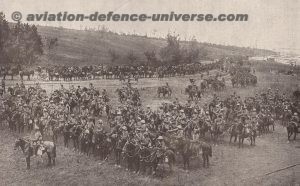
In addition to the regular Indian Army, the armies of the Princely States and regiments of the Auxiliary Force (European volunteers) could also be called upon to assist in an emergency. The Princely States formed the Imperial Service Brigades and in 1914, had 22,613 men in 20 cavalry regiments and 14 infantry battalions. By the end of the war 26,000 men had served overseas on Imperial Service. The Auxiliary force could field another 40,000 men in 11 regiments of horse and 42 volunteer infantry battalions. Also available were the Frontier Militia and the Military Police which could field 34,000 men between them.
The field force headquarters was located in Delhi and the senior officer (Commander-in-Chief, India) was assisted by a Chief of the General Staff, India. All the senior command and staff positions in the Indian Army alternated between senior officers of the British and Indian Armies. In 1914, the Commander–in–Chief was General Sir Beauchamp Duff of the Indian Army, and the Chief of the General Staff was Lieutenant General Sir Percy Lake of the British Army. Each Indian battalion was staffed by 13 officers from the British Army in India and 17 officers from the Indian Army— expatriate British officers serving under colonial Indian administration. As the war intensified and officer casualties mounted, the ability to replace casualties with officers of British origin became extremely difficult and in many cases the officer allotment to battalions was reduced accordingly. Only in 1919 were the first Officer Cadets of Indian descent permitted to be selected for officer training at the Royal Military College.
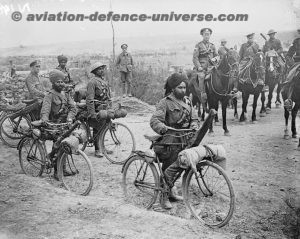
The normal annual recruitment for the Indian army was 15,000 men, during the course of the war over 800,000 men volunteered for the army and more than 400,000 volunteered for non-combatant roles. In total almost 1.3 million men had volunteered for service by 1918. Over one million Indian troops served overseas during the war. In total, at least 74,187 Indian soldiers died in World War I.
In 1901 oil had been discovered in commercial quantities at Masjid-e-Suleiman at the head of the Persian Gulf. At the start of the war in 1914, the privately owned Anglo-Persian Oil Company which owned the concessions for these fields was about to be bought by the British Government, primarily to fuel the British Fleet. It soon became clear that the Ottoman Turkish Army was being mobilised and in August the Indian Government was instructed to prepare contingency plans to protect these strategic assets. The plans dictated that in the event of the Turkish Army coming out in support of the Germans, the Indian Army was to act to secure the oilfields. As a contingency, the Indian Expeditionary Force D (see below) under command of Lieutenant–General Sir Arthur Barrett sailed from Bombay on 16 October 1914 for Bahrain. They, together with Expeditionary Force A who had been hurriedly sent to Europe at the end of September in response to a request from the Imperial General Staff for men to support the war effort— became the first Indian elements committed to war outside of India.
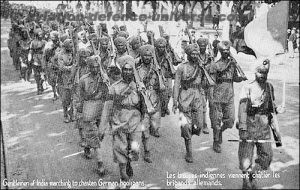
In addition to the permanent divisions, the Indian Army also formed a number of independent brigades. As part of the Southern Army the Aden Brigade was stationed in the Aden Protectorate on the strategically important naval route from Europe to India, where there was limited fighting. The Bannu Brigade, the Derajat Brigade and the Kohat Brigade were all part of the Northern Army and they were deployed along the North West Frontier. On 12 May 1918, the Bannu and Derajat brigades were designated as the Waziristan Field Force under the command General G W Baynon. The South Persia Brigade was formed in 1915 at the start of the Persian Campaign to protect the Anglo–Persian oil installations in south Persia and the Persian Gulf.
In November 1916, the two Indian cavalry divisions were renumbered from 1st and 2nd to the 4th and 5th Cavalry Divisions. Serving alongside British cavalry divisions they were held behind the front line awaiting the hoped for breakthrough. At times during the war they served in the trenches as infantry, each cavalry brigade when dismounted formed a dismounted regiment. This meant that when the divisions went into the front line, they could only cover a brigade area. Before being themselves withdrawn to Egypt in March 1918, they took part in the Battle of the Somme, the Battle of Bazentin, the Battle of Flers-Courcelette, the advance to the Hindenburg Line and finally the Battle of Cambrai. Of the 130,000 Indians who served in France and Belgium, almost 9,000 died.
In 1914, the Governor of British East Africa requested assistance to deal with the German forces in German East Africa and the problem was handed to the India Office, which assembled two forces and shipped them to his aid. Indian Expeditionary Force B consisted of the 27th (Bangalore) Brigade from the 9th (Secunderabad) Division and an Imperial Service Infantry Brigade, a pioneer battalion, a mountain artillery battery and engineers were sent to Tanganyika with the task of invading German East Africa. The force under the command of Major General Arthur Aitken landed at Tanga on 2–3 November 1914. In the following Battle of Tanga, Aitkens’ 8,000 men were badly beaten by the 1,000 men under their German commander Paul von Lettow-Vorbeck. The force re-embarked on 5 November 1914, having suffered 817 casualties and the loss of several hundred rifles, 16 machine guns and 600,000 rounds of ammunition.
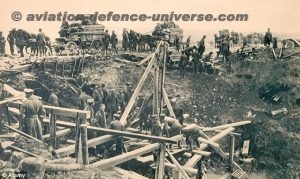
Indian troops manning a QF 3 pounder Hotchkiss gun mounted in a railway wagon on the military railway between Basra and Nasiriya. The largest Indian Army force to serve abroad was the Indian Expeditionary Force D in Mesopotamia, under the command of Lieutenant-General Sir John Nixon.The first unit sent in November 1914, was the 6th (Poona) Division and they were tasked with guarding British oil installations in and around Basra. As part of the Mesopotamian campaign they served under the command of Major General Barrett and then under Major General Townshend. After a string of early successes, the campaign was delivered a setback at the Battle of Ctesiphon in November 1915 due to logistical constraints. Following this engagement, the Poona Division withdrew back to Kut, where Townshend made the decision to hold the city and the Siege of Kut began.
In 1917, the British force, under Frederick Stanley Maude, which now included one cavalry and seven infantry divisions from the Indian Army, in the III Corps (India) advanced towards Baghdad which was captured in March.[clarification needed] The advance continued in 1918, and after the Battle of Sharqat in October, the Turkish forces surrendered and the Armistice of Mudros was signed. The Mesopotamian campaign was largely an Indian Army campaign as the only British formations involved were the 13th (Western) Division and British battalions assigned to Indian brigades. In the campaign, 11,012 were killed, 3,985 died of wounds, 12,678 died of disease, 13,492 were either missing or prisoners (including the 9,000 prisoners from Kut), and 51,836 were wounded.
Indian Expeditionary Force E consisted of the 22nd (Lucknow) Brigade sent to Egypt in October 1914. The designation was retained for all subsequent forces sent there. Two Indian cavalry divisions (4th Cavalry Division and 5th Cavalry Division) transferred from France in 1918, for service in Palestine. They were joined by the 15th Imperial Service Cavalry Brigade, a unit formed by three regiments of Lancers from the princely states of Mysore, Hyderabad, and Jodhpur. The 3rd (Lahore) Division and the 7th (Meerut) Division were transferred from Mesopotamia. At the same time 36 Indian army battalions were sent to reinforce the British 10th (Irish), 53rd (Welsh), 60th (2/2nd London) and 75th Divisions, which were reformed on Indian division lines with one British and three Indian battalions per brigade.
Indian Expeditionary Force F consisted of the 10th Indian Division and the 11th Indian Division both of which were formed in Egypt in 1914, to defend the Suez canal. Other formations attached were the regular 22nd (Lucknow) Brigade from the 8th Lucknow Division without their British battalions and an Imperial Service Cavalry Brigade.
The 10th Division was disbanded in 1916, and its brigades assigned to other formations. The 28th Indian Brigade was assigned to the 7th (Meerut) Division in 1915; the 29th Indian Brigade served as an independent brigade in the Gallipoli campaign, and then disbanded in June 1917; and the 30th Indian Brigade was first assigned to the 12th Indian Division in April 1915, then transferred to the 6th (Poona) Division in September 1915 and was captured in the fall of Kut.
The 11th Division was disbanded earlier in 1915, but its brigades did not survive much longer. The 22nd (Lucknow) Brigade was broken up in January 1916; the 31st Indian Brigade joined the 10th Division in January 1916, but was disbanded a month later; and the 32nd (Imperial Service) Brigade was disbanded in January 1916.
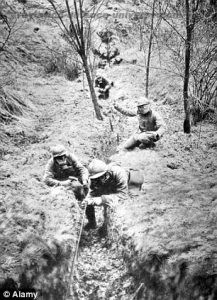
In April 1915, Indian Expeditionary Force G was sent to reinforce the Gallipoli Campaign. It consisted of the 29th Brigade, serving away from its parent 10th Indian Division. Consisting of three battalions of Ghurkhas and one of Sikhs, the brigade was dispatched from Egypt and attached to the British 29th Division which had been decimated in the earlier battles. Held in reserve for the Second Battle of Krithia they played a major part in the Third Battle of Krithia. Advancing on the left the Brigade was quickly halted except along the Aegean shore where the 1/6th Gurkha Rifles managed to advance. The 14th Ferozepore Sikhs, advancing along the floor of Gully Ravine, were almost wiped out, losing 380 men out of 514 and 80% of their officers. The Brigade was next involved in the Battle of Gully Ravine and here the 2/10th Gurkha Rifles managed to advance half a mile. The Brigade next took part in the Battle of Sari Bair, under cover of a naval bombardment the 1/6th Gurkha Rifles assaulted and captured the hill, which was then shelled by the Royal Navy.
One Indian Army battalion that was part of the Garrison of Tianjin in China, the 36th Sikhs took part in the Siege of Tsingtao. Tsingtao was a German controlled port in China. The British Government and the other Allied European powers were concerned about Japanese intentions in the region and decided to send a small symbolic British contingent from Tianjin in an effort to allay their fears. The 1,500-man contingent was commanded by Brigadier-General Nathaniel Walter Barnardiston and consisted of 1,000 soldiers of the 2nd Battalion, South Wales Borderers who were later followed by 500 soldiers of the 36th Sikhs. The Japanese led force laid siege to the port between 31 October–7 November 1914. At the end of the siege, Japanese army casualties numbered 236 killed and 1,282 wounded; the British / Indians had 12 killed and 53 wounded. The German defenders suffered 199 dead and 504 wounded.
850 sepoys comprising the 5th Light Infantry had arrived in Singapore from Madras in October 1914. They had been sent to replace the Yorkshire Light Infantry, which had been ordered to France. The 5th Light Infantry consisted of roughly equal numbers of Punjabi Muslims and Pathans serving in separate companies.
500 men of the 19th Punjabis were deployed by General Wilfrid Malleson in Transcaspia in support of the Ashkhabad Committee, and known as the Malleson Mission. The Ashkhabad Committee was a revolutionary organisation led by Mensheviks and Socialist Revolutionaries who were in an armed conflict with the Bolshevik Tashkent Soviet.
Not only did the India soldiers fight bravely but also attained martyrdom with glory. The stories are innumerable and not humanly possible to document. India Gate in New Delhi, built in 1931, commemorates the Indian soldiers who lost their lives fighting in World War I. But as the world celebrates 100 years of their contribution, ADU salutes the Indian Army and its role in the Great War.
Compiled by Team ADU. Content courtesy : British Archives . Photos Courtesy:British Archives & Alamy


































